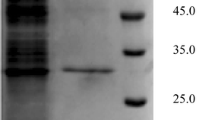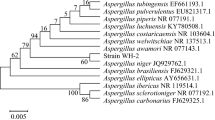Abstract
Substrate-directed screening was carried out to find bacteria that could deacylate O-acetylated mandelic acid from environmental samples. From more than 200 soil isolates, we identified for the first time that Pseudomonas sp. ECU1011 biocatalytically deacylated (S)-α-acetoxyphenylacetic acid with high enantioselectivity (E > 200), yielding (S)-mandelic acid with 98.1% enantiomeric excess (ee) at a 45.5% conversion rate. The catalytic deacylation of (S)-α-acetoxyphenylacetic acid by the resting cell was optimized using a single-factor method to yield temperature and pH optima of 30°C and 6.5, respectively. These optima help to reduce the nonselective spontaneous hydrolysis of the racemic substrate. It was found that substrate concentrations up to 60 mM could be used. 2-Propanol was used as a moderate cosolvent to help the substrate disperse in the aqueous phase. Under optimized reaction conditions, the ee of the residual (R)-α-acetoxyphenylacetic acid could be improved further, to greater than 99%, at a 60% conversion rate. Furthermore, using this newly isolated strain of Pseudomonas sp. ECU1011, three kinds of optically pure analogs of (S)-mandelic acid and (R)-α-acetoxyphenylacetic acid were successfully prepared at high enantiomeric purity.











Similar content being viewed by others
References
Amoroso R, Bettoni G, Tricca ML, Ferorelli FLS (1998) Direct resolution of α-monoalkyl-α-aryloxyacetic acids via ester or imide derivatives. Il Farmaco 53:73–79
Bernhardt P, O’Connor SE (2009) Opportunities for enzyme engineering in natural product biosynthesis. Curr Opin Chem Biol 13:1–8
Blay G, Fernandez I, Molina E, Munoz MC, Pedro JR, Vila C (2006a) Diastereoselective Michael addition of (S)-mandelic acid enolate to 2-arylidene-1, 3-diketones: enantioselective diversity-oriented synthesis of densely substituted pyrazoles. Tetrahedron 62:8069–8076
Blay G, Fernandez I, Monje B, Munoz MC, Pedro JR, Vila C (2006b) Enantioselective synthesis of 2-substituted-1, 4-diketones from (S)-mandelic acid enolate and α, β-enones. Tetrahedron 62:9174–9182
Cabrera Z, Fernandez-Lorente G, Fernandez-Lafuente R, Palomo JM, Guisan JM (2009) Novozym 435 displays very different selectivity compared to lipase from Candida antarctica B adsorbed on other hydrophobic supports. J Mol Catal B: Enzym 57:171–176
Chataigner I, Lebreton J, Durand D, Guingant A, Villieras J (1998) A new approach for the determination of the absolute configuration of secondary alcohols by 1H NMR with O-substituted mandelate derivatives. Tetrahedron Lett 39:1759–1762
Chen YZ, Xu JZ, Xu XY, Xia Y, Lin H, Xia SW, Wang LX (2007) Enantiocomplementary preparation of (S)- and (R)-mandelic acid derivatives via α-hydroxylation of 2-arylacetic acid derivatives and reduction of α-ketoester using microbial whole cells. Tetrahedron: Asymmetry 18:2537–2540
Chikusa Y, Hirayama Y, Ikunaka M, Inoue T, Kamiyama S, Moriwaki M, Nishimoto Y, Nomoto F, Ogawa K, Ohno T, Otsuka K, Sakota AK, Shirasaka N, Uzura A, Uzura K (2003) There’s no industrial biocatalyst like hydrolase: development of scalable enantioselective processes using hydrolytic enzymes. Org Process Res Dev 7:289–296
Fernandez-Lorente G, Fernandez-Lafuente R, Palomo JM, Mateo C, Bastida A, Coca J, Haramboure T, Hernandez-Justiz O, Terreni M, Guisan JM (2001) Biocatalyst engineering exerts a dramatic effect on selectivity of hydrolysis catalyzed by immobilized lipases in aqueous medium. J Mol Catal B: Enzym 11:649–656
Fernandez-Lorente G, Palomo JM, Guisan JM, Fernandez-Lafuente R (2007) Effect of the immobilization protocol in the activity, stability, and enantioselectivity of Lecitase® Ultra. J Mol Catal B: Enzym 47:99–104
He YC, Xu JH, Xu Y, Ouyang LM, Pan J (2007) Biocatalytic synthesis of (R)-(−)-mandelic acid from racemic mandelonitrile by a newly isolated nitrilase-producer Alcaligenes sp. ECU0401. Chin Chem Lett 18:677–680
Huang HR, Xu JH, Xu Y, Pan J, Liu X (2005) Preparation of (S)-mandelic acids by enantioselective degradation of racemates with a new isolate Pseudomonas putida ECU1009. Tetrahedron: Asymmetry 16:2113–2117
Huang HR, Xu JH (2006) Preparation of (S)-mandelic acid from racemate using growing cells of Pseudomonas putida ECU1009 with (R)-mandelate degradation activity. Biochem Eng J 30:11–15
Jackson MA, Labeda DP, Becker L (1995) An enantioselective hydrolysis of ethyl 2-hydroxyalkanoates by an extracellular esterase from a Bacillus sphaericus strain. Enzyme Microb Technol 17:175–179
Kaul P, Banerjee A, Mayilraj S, Banerjee UC (2004) Screening for enantioselective nitrilases: kinetic resolution of racemic mandelonitrile to (R)-(−)-mandelic acid by new bacterial isolates. Tetrahedron: Asymmetry 15:207–211
Linhart I, Smejkal BJ, Mladkova I (1998) Stereochemical aspects of styrene biotransformation. Toxicol Lett 94:127–135
Liu ZQ, Li Y, Ping LF, Xu YY, Cui FF, Xue YP, Zheng YG (2007) Isolation and identification of a novel Rhodococcus sp. ML-0004 producing epoxide hydrolase and optimization of enzyme production. Process Biochem 42:889–894
Liu ZQ, Sun ZH (2004) Cloning and expression of d-lactonohydrolase cDNA from Fusarium moniliforme in Saccharomyces cerevisiae. Biotechnol Lett 26:1861–1865
Mateo C, Chmura A, Rustler S, van Rantwijk F, Stolzb A, Sheldon RA (2006) Synthesis of enantiomerically pure (S)-mandelic acid using an oxynitrilase–nitrilase bienzymatic cascade: a nitrilase surprisingly shows nitrile hydratase activity. Tetrahedron: Asymmetry 17:320–323
Strauss UT, Faber K (1999) Deracemization of (±)-mandelic acid using a lipase–mandelate racemase two-enzyme system. Tetrahedron: Asymmetry 10:4079–4081
Thompson JD, Higgins DG, Gibson TJ (1994) CLUSTALW: improving the sensitivity of progressive multiple sequence alignment through sequence weighting, position specific gap penalties and weight matrix choice. Nucleic Acids Res 22:4673–4680
Utkin IB, Yakimov MM, Matveeva LN, Kozlyak EI, Rogozhin IS, Solomon ZG, Bezborodov AM (1991) Degradation of styrene and ethylbenzene by Pseudomonas species Y2. FEMS Microbiol Lett 77:237–241
Wang PY, Chen TL, Tsai SW, Kroutil W (2007) Hydrolytic resolution of (R, S)-2-hydroxycarboxylic acid esters in biphasic media: implication for rate-limiting formation or breakdown of tetrahedral intermediates in acylation step. Biotechnol Bioeng 98:30–38
Wang PY, Tsai SW, Chen TL (2008) Improvements of enzyme activity and enantioselectivity via combined substrate engineering and covalent immobilization. Biotechnol Bioeng 101:460–469
Wilson K (1997) Preparation of genomic DNA from bacteria. In: Ausubel FM, Kingston RE, Moore DD, Seidman JG, Smith JA, Struhl K (eds) Current protocols in molecular biology. Wiley, New York, pp 241–24
Yamamoto K, Oishi K, Fujimatsu I, Komatsu K (1991) Production of (R)-(−)-mandelic acid from mandelonitrile by Alcaligenes faecalis ATCC 8750. Appl Environ Microbiol 57:3028–3032
Yang W, Xu JH, Xie Y, Xu Y, Zhao G, Lin GQ (2006) Asymmetric reduction of ketones by employing Rhodotorula sp. AS2.2241 and synthesis of the β-blocker (R)-nifenalol. Tetrahedron: Asymmetry 17:1769–1774
Acknowledgments
This research was financially supported by the National Natural Science Foundation of China (grant nos. 20506037 and 20773038), the Ministry of Science and Technology (grant nos. 2007AA02Z225 and 2009CB724704), and the China National Special Fund for State Key Laboratory of Bioreactor Engineering (grant no. 2060204).
Author information
Authors and Affiliations
Corresponding author
Rights and permissions
About this article
Cite this article
Ju, X., Yu, HL., Pan, J. et al. Bioproduction of chiral mandelate by enantioselective deacylation of α-acetoxyphenylacetic acid using whole cells of newly isolated Pseudomonas sp. ECU1011. Appl Microbiol Biotechnol 86, 83–91 (2010). https://doi.org/10.1007/s00253-009-2286-z
Received:
Revised:
Accepted:
Published:
Issue Date:
DOI: https://doi.org/10.1007/s00253-009-2286-z




